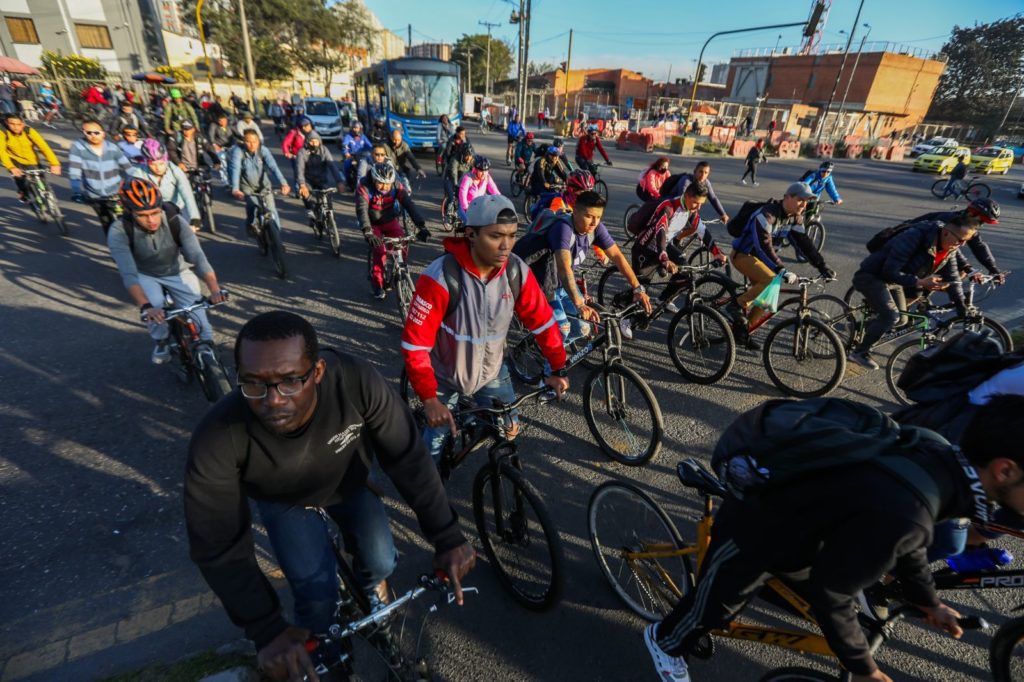
Once again, the city of Bogota is joining the celebration of the Day Without Cars and Motorcycles. The day is proceeding normally in the Colombian capital, where it is expected that around 1,900,000 private cars will not be circulating on the streets, along with approximately 450,000 motorcycles.
On this day, only electric vehicles or those with a capacity of more than 10 passengers, as well as white-plated vehicles (which are typically used by professionals in the sector such as taxis, transporters, school buses, emergency vehicles, and cash transporters), are allowed to circulate.
The event takes place from 5 in the morning until 9 in the evening. To avoid affecting citizens’ mobility, the city administration has planned for the full-capacity operation of the mass public transportation system, Transmilenio, on its main routes. Additionally, there will be an increase in bus service lines, especially during peak hours. This means that a total of 39,249 buses will circulate throughout the city during the day, from 4 am to 11 pm.
A high influx of users is also expected on the 630 km of cycle lanes, with shared bicycles and parking spaces specially designated for bikes. There will also be an increase in pedestrian routes if the distance is not too long. In this regard, the city administration has reported the availability of 3,350 kilometers of pedestrian networks to facilitate the connection and coordination of mobility systems.
Once a Year
Mobility is one of the most pressing issues in Bogota. The city still lacks an adequate public transportation system due to the perennial delays in the construction of the metro. Nevertheless, once a year, the capital joins the worldwide celebration of the Day Without Cars and Motorcycles. This initiative, which has become an annual tradition since its inception in 2000, aims to promote sustainable mobility, reduce pollution, and foster greater environmental awareness in the city.
The Day Without Cars and Motorcycles in Bogota originated from the need to address the growing problems of traffic congestion and air pollution in the city. The first event took place on February 24, 2000, when the circulation of private cars and motorcycles throughout the city was prohibited for an entire day. The idea behind this initiative was to give Bogotans the opportunity to experience a cleaner and quieter city while promoting the use of more sustainable transportation alternatives, such as bicycles and public transportation.
The event was a resounding success, and since then, it has become an annual tradition in Bogota. The Day Without Cars and Motorcycles is celebrated on the first Thursday of February each year, inviting citizens to leave their vehicles at home and use more environmentally friendly modes of transportation.

Objectives of the Day Without Cars and Motorcycles
The Day Without Cars and Motorcycles in Bogota has several important objectives:
- Reduce air pollution: Prohibiting motorized vehicles for a day significantly contributes to improving air quality in the city. This benefits residents’ health and reduces respiratory problems associated with pollution.
- Promote sustainable mobility: The event encourages people to choose more sustainable means of transportation, such as bicycles, public transportation, or simply walking. This reduces the reliance on cars and motorcycles, decreasing long-term traffic congestion.
- Raise environmental awareness: The Day Without Cars and Motorcycles educates the community about the negative impacts of air pollution and excessive use of motorized vehicles on the environment. It promotes greater awareness of the need to protect the natural environment.
Mitigating Negative Impacts
To mitigate potential negative impacts, especially on the city’s commerce, Bogota authorities implement various measures:
- Flexible hours: The implementation of flexible working hours for businesses is encouraged, allowing employees to arrive and leave work at times that better suit mobility restrictions.
- Promotion of local commerce: Campaigns are conducted to promote local commerce before and after the Day Without Cars and Motorcycles, encouraging citizens to shop in advance or after the car-free day.
- Cultural and recreational events: To attract people to the streets and promote local tourism, cultural and recreational events are organized throughout the city during the Day Without Cars and Motorcycles.
The Day Without Cars and Motorcycles in Bogota is a successful initiative that aims to transform the city’s mobility and promote a more sustainable future. While it may have temporary impacts on commerce, mitigation measures and long-term environmental benefits make this day worthwhile, according to experts and the majority of the population.
In this regard, Bogota continues to lead the way in Colombia toward a cleaner and more environmentally friendly transportation model, hoping for the much-anticipated improvement in public transportation—an essential option in a city with nearly 8 million inhabitants in its urban core that needs to enhance mobility by reducing the use of private vehicles in favor of efficient and environmentally friendly public transportation.
See all the latest news from Colombia and the world at ColombiaOne.com. Contact our newsroom to report an update or send your story, photos and videos. Follow Colombia One on Google News, Facebook, Instagram, and subscribe here to our newsletter.

